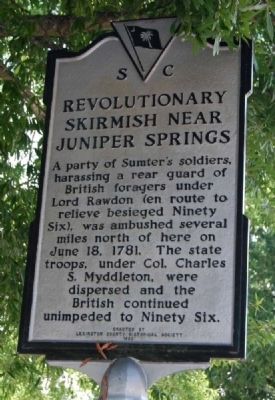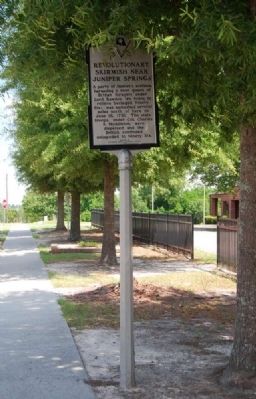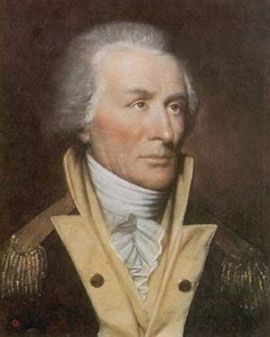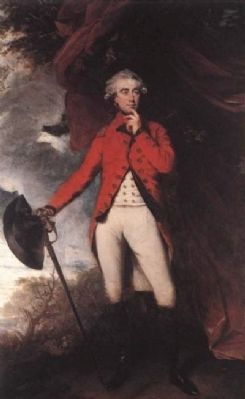Gilbert in Lexington County, South Carolina — The American South (South Atlantic)
Revolutionary Skirmish Near Juniper Springs
Erected 1980 by Lexington County Historical Society. (Marker Number 32-18.)
Topics. This historical marker is listed in this topic list: War, US Revolutionary. A significant historical month for this entry is June 1854.
Location. 33° 55.067′ N, 81° 23.617′ W. Marker is in Gilbert, South Carolina, in Lexington County. Marker is on Main Street south of Rikard Circle, on the left when traveling south. Touch for map. Marker is at or near this postal address: 314 Main Street, Gilbert SC 29054, United States of America. Touch for directions.
Other nearby markers. At least 10 other markers are within 9 miles of this marker, measured as the crow flies. Lewie Chapel (Old Gilbert Methodist Church) / The Lewie Family (approx. half a mile away); Hartley House (approx. 7.1 miles away); Pinarea / Quattlebaum Sawmill, Flour Mill, and Rifle Factory (approx. 7.3 miles away); Moorefield Memorial Highway (approx. 7.3 miles away); Lee's Tavern Site (approx. 7.7 miles away); Old Batesburg-Leesville High School (approx. 7.8 miles away); St. Peter's (Meetze's) Lutheran Church (approx. 7.9 miles away); Site of the "Swamp Rabbit" Bridge / The Swamp Rabbit (approx. 8.1 miles away); Blinding of Isaac Woodard (approx. 9 miles away); Batesburg Institute (approx. 9 miles away).
Also see . . .
1. Thomas Sumter. Thomas Sumter (August 14, 1734 – June 1, 1832) was a hero of the American Revolution and went on to become a longtime member of the Congress of the United States. (Submitted on August 24, 2009, by Brian Scott of Anderson, South Carolina.)
2. Francis Rawdon-Hastings, 1st Marquess of Hastings. Francis Rawdon-Hastings, 1st Marquess of Hastings KG PC (9 December 1754 – 28 November 1826), styled The Honourable Francis Rawdon from birth until 1762 and as The Lord Rawdon between 1762 and 1783 and known as The Earl of Moira between 1793 and 1816, was a British politician and military officer who served as Governor-General of India from 1813 to 1823. (Submitted on August 24, 2009, by Brian Scott of Anderson, South Carolina.)
Additional commentary.
1. About Juniper Springs
Juniper Springs, South Carolina
18 June 1781
Lord Francis Rawdon marched from Camden to fort at Ninety-Six with a relief force of 2,000 men. Sumter was ordered by Greene to slow down the approaching British relief column. It was not realistic for any of the partisan units to attack Rawdon, but they could conduct hit and run tactics to delay him. Sumter sent two hundred South Carolina State cavalry to William Washington to harass Rawdon’s army on the Ridge Road. He also sent 150 men with Colonel Charles Myddleton and Richard Hampton to harass Rawdon’s rear.
Myddleton was successful in harassing Rawdon’s foraging parties, and was able to capture and officer and four men. He sent the prisoners away quickly with an escort and prepared to receive any attack that would be coming.
On the morning of June 18th Major John Coffin, in the British rear guard, set an ambush for Myddleton. When Myddleton’s force engaged the ambush Coffin surrounded the partisan’s flanks and rear with cavalry.
Myddleton’s cavalry had no swords and his force was not equipped for close combat. They were decimated by the ambush. Four officers and twenty or thirty men were killed or taken prisoner.
During the fighting Jacob Presnell was lying down behind a tree, firing at the British. He told the men around him, "Damn ‘em, let 'em come one!" Richard Hampton saw that they were surrounded and told his men to retreat, saying "Boys, follow me!" Presnell
didn’t get the word to withdraw and stood his ground until the British were close to him. He looked around and noticed that he was alone and quickly ran for his unbridled pony. He jumped on the horse, but it would not move a step. He jumped back off again and grabbed the pony’s mane, and "holding his rifle in his other hand he kicked the poney in the side." He stayed on the side not exposed to enemy fire, and ran off the field. He rendezvoused with the rest of his force at Hollow Creek Swamp.
Myddleton’s cavalry became severely demoralized and only forty-five men could be reorganized after the ambush. Sumter reported the loss of his cavalry to Greene and told him that it would be very difficult to join him at Ninety-Six.
Daniel Stinson told Draper that Vaudant’s Old Field was used by the British as a collection point for their dead and wounded after the skirmishing with Sumter’s mounted troops in June. The British would bury their dead beside a "big post oak". The British hanged two of their own men, reason’s unknown, from that post oak. In the middle of the hanging they thought Sumter’s partisans had come back and they quickly left the area. The two men hanged there for three months until they were found, cut down and buried. William Calk said that he saw four British graves, four American graves, and the two who had been left to hang.
The British continued on to Fort Ninety-Six. Five miles from the Juniper Springs battlefield Daniel Stinson said that they "came on an old man named Palmer, whom they killed without mercy." (Source: Nothing But Blood and Slaughter: The Revolutionary War in the Carolinas, Vol. III by Patrick O'Kelley, pgs 274-276.)
— Submitted August 23, 2009, by Brian Scott of Anderson, South Carolina.
Credits. This page was last revised on December 14, 2019. It was originally submitted on August 23, 2009, by Brian Scott of Anderson, South Carolina. This page has been viewed 2,052 times since then and 59 times this year. Photos: 1, 2. submitted on August 23, 2009, by Brian Scott of Anderson, South Carolina. 3, 4. submitted on August 24, 2009, by Brian Scott of Anderson, South Carolina.



